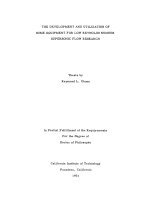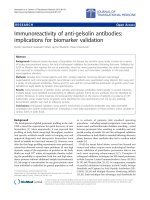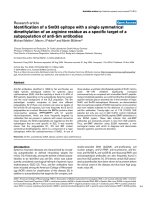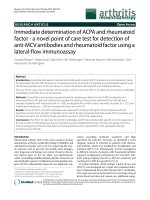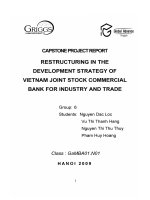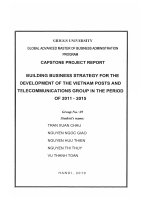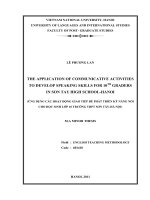Application of recombinant antibody technology for the development of anti lipid antibodies for tuberculosis diagnosis
Bạn đang xem bản rút gọn của tài liệu. Xem và tải ngay bản đầy đủ của tài liệu tại đây (5.33 MB, 240 trang )
APPLICATION OF RECOMBINANT ANTIBODY
TECHNOLOGY FOR THE DEVELOPMENT OF ANTI-LIPID
ANTIBODIES FOR TUBERCULOSIS DIAGNOSIS
CONRAD CHAN EN ZUO
NATIONAL UNIVERSITY OF SINGAPORE
2013
APPLICATION OF RECOMBINANT ANTIBODY
TECHNOLOGY FOR THE DEVELOPMENT OF ANTI-LIPID
ANTIBODIES FOR TUBERCULOSIS DIAGNOSIS
CONRAD CHAN EN ZUO
BSc. (Hons.), MRes. Imperial College London
A THESIS SUBMITTED
FOR THE DEGREE OF DOCTOR OF PHILOSOPHY
DEPARTMENT OF MICROBIOLOGY
NATIONAL UNIVERSITY OF SINGAPORE
2013
DECLARATION
I hereby declare that this thesis is my original work and it has been written by me in
its entirety. I have duly acknowledged all the sources of information which have been
used in the thesis.
This thesis has also not been submitted for any degree in any university previously
__________________________
Conrad Chan En Zuo
5
th
August 2013
Acknowledgements
i
Acknowledgements
The work here would not have been possible without the assistance of so
many people. Firstly, to A/Prof Paul MacAry and Dr. Brendon Hanson, my co-
supervisors, thank you for your encouragement, advice, support and the opportunity
to carry out research in a very exciting field. Also to my collaborators with whom I
had the privilege of working with over these five years; From NUS: Dr Timothy
Barkham, Dr Seah Geok Teng, Prof Markus Wenk, Dr Anne Bendt, Dr Amaury
Cazenave-Gassiot; From FIND: Dr Gerd Michel, From Max Planck Institute Berlin:
Prof Peter Seeberger & Sebastian Gotze, From Georgia: Dr Nestan Tukvadze and
the staff of the TB Institute, Dr Mason Soule and Dr Mzia Kutateladze, I really
appreciate the sharing of your scientific expertise and efforts. A special note of
thanks to those in Georgia, who made my trip a real pleasure. To all my fellow
colleagues at DSO National Laboratories, Annie, Steve, Angeline, Shyue Wei, De
Hoe, Grace and Shirley, thanks for all your assistance and encouragement and for
covering all the stuff I could not do. The same to my fellow students & colleagues in
PAM Lab especially those in the Lipid Squad: Omedul and Yanting, as well as
Fatimah for doing all those admin stuff that we hate to do. I would also like to
acknowledge the support of DSO National Laboratories for providing the scholarship
to support my studies. Finally, to God, for His innumerable blessings and provision
along the way; and to my family and especially my wife Sally, this is as much your
success as it is mine.
Table of Contents
ii
Table of Contents
Acknowledgements 1
Table of Contents ii
Summary viii
List of Tables x
List of Figures xi
List of Abbreviations xiv
List of Publications & Patents xvii
Chapter 1: Introduction 1
1.1 Tuberculosis pathology, epidemiology, prevention and treatment 2
1.2 Methods for TB diagnosis 7
1.2.1 Detection of host immune responses- X-rays, TST and IGRA 8
1.2.2 Direct microbiological detection – Acid-fast stain, microbial culture and
Nucleic acid amplification tests 9
1.3 TB diagnostics in resource-poor settings 12
1.3.1 Improving current diagnostics for resource-poor countries 13
1.3.2 Potential point-of care diagnostics for resource-poor countries 15
1.4 Anti-lipid antibodies 18
1.4.1 Lipids as disease biomarkers 18
1.4.2 Recombinant phage display 20
1.4.3 Recombinant antibody expression 21
Table of Contents
iii
1.5 Lipid biomarkers for TB diagnostics 23
1.5.1 Lipoarabinomannan 25
1.5.2 LAM diagnostics 29
1.5.3 Mycolic acid 31
1.6 Aims of this thesis 35
1.6.1 Optimize expression of full length IgG in E. coli 36
1.6.2 Develop antibodies targeting the Mtb lipids Lipoarabinomannan and
mycolic acid 36
1.6.3 Thoroughly characterize anti-LAM/anti-mycolic acid antibodies 37
1.6.4 Determine the diagnostic utility of the antibodies 37
Chapter 2: Materials and methods 38
2.1 Buffers and solutions 39
2.2 Construction of antibody expression vectors 42
2.2.1 Construction of mammalian expression vectors 42
2.2.2 Construction of bacterial expression vectors 43
2.2.3 Construction of chimeric antibody constructs 43
2.2.4 Sub-cloning of antibody heavy and light chains by restriction digest and
ligation 46
2.3 Expression and purification of bacterial lgG 46
2.3.1 Initial periplasmic expression in BL21 or HB2151 46
2.3.2 Small scale optimization of bacterial IgG expression conditions 47
2.3.3 Large-scale expression and purification of bacterial IgG 47
Table of Contents
iv
2.4 Expression and purification of mammalian IgG and Fab 48
2.5 Polyacrylamide gels and western blot 50
2.6 Measurement of protein concentration 50
2.7 Bacterial strains and culture 51
2.8 Phage display 52
2.8.1 Negative selection panning against ManLAM 52
2.8.2 Lipid panning against mycolic acid 53
2.8.3 Phage recovery after each round of panning 54
2.8.4 Screening of phage libraries 55
2.9 Carbohydrate microarrays 57
2.10 Immunofluorescence and acid fast-staining 58
2.11 Collection and processing of bacterial cultures for ELISA 59
2.11.1 Bacterial supernatants and whole cell suspension for LAM ELISA 59
2.11.2 Lipid extraction from bacterial cultures for mycolic acid ELISA 60
2.12 Collection of clinical samples for ELISA 61
2.12.1 Spiked whole blood and serum samples for LAM ELISA 61
2.12.2 TB patient selection criteria and sample collection procedure 62
2.12.3 Clinical patient serum samples for LAM ELISA 63
2.12.4 Clinical patient urine samples for LAM ELISA 63
2.12.5 Clinical patient sputum samples for LAM ELISA 63
2.12.6 Clinical patient sputum samples for mycolic acid ELISA 64
Table of Contents
v
2.13 ELISAs 64
2.13.1 Comparison of functional IgG levels in bacterial lysate and determination
of purified bacterial IgG affinity curves by indirect ELISA 64
2.13.2 Indirect phage polyclonal and monoclonal ELISAs 66
2.13.3 Indirect monoclonal IgG ELISA against LAM or lipids 67
2.13.4 Determination of chimeric antibody affinity binding curves 68
2.13.5 Determination of limit of sensitivity for anti-mycolic acid antibodies 69
2.13.6 Indirect sandwich ELISA on purified LAM, bacterial suspensions and
culture supernatants 69
2.13.7 Determination of anti-LAM antibody titres in healthy serum samples 70
2.13.8 Indirect sandwich ELISA on spiked or patient clinical samples 71
2.13.9 Indirect ELISA on patient lipid extracts 71
2.14 Mass spectrometric profiling and quantification of mycolic acids. 72
2.15 Data analysis and statistics 73
Chapter 3: Optimization of IgG expression in bacteria 74
3.1 Introduction 75
3.2 Preliminary expression in two common E. coli bacterial strains 76
3.3 Optimization of expression in small scale culture 78
3.4 Comparison of yield by large scale expression 83
3.5 Comparison of bacterial and mammalian expressed IgG 85
3.6 Discussion 87
Chapter 4: Generation of anti-ManLAM antibodies by phage display 91
Table of Contents
vi
4.1 Introduction 92
4.2 Panning of the Humanyx phage library 93
4.3 Monoclonal screening and identification of my2F12 95
4.4 Characterization of my2F12 specificity 97
4.5 Expression of my2F12 in bacteria 101
4.6 Discussion 105
Chapter 5: Optimization of my2F12 antibody and sample processing for diagnostic
use 108
5.1 Introduction 109
5.2 Design and expression of my2F12 chimeric antibodies 111
5.3 Characterization of my2F12 chimeric antibody avidity 114
5.4 Identification of pathogenic mycobacteria with chimeric my2F12 by
immunofluorescence microscopy 115
5.5 Identification of pathogenic mycobacteria with chimeric my2F12 by sandwich
ELISA 120
5.6 Enhancing the sensitivity of my2F12 ELISA on spiked serum samples 122
5.7 Discussion 127
Chapter 6: Generation of anti-mycolic acid antibodies by phage display 131
6.1 Introduction 132
6.2 Isolation of mycolic acid-specific antibodies 133
6.3 Characterization of mycolic acid antibody specificity and sensitivity 137
6.4 Optimization of mycolic acid extraction protocol 142
6.5 Determination of species specificity 146
Table of Contents
vii
6.6 Determination of CFU limit of detection 147
6.7 Discussion 149
Chapter 7: Validation of antibodies on clinical samples 155
7.1 Introduction 156
7.2 Optimization of assay antibody concentration 158
7.3 Testing of clinical samples for ManLAM 159
7.4 Analysis of results by individual patient groups 164
7.5 Analysis of combined data 166
7.6 Conversion of mc3 to chimeric antibody for diagnostic use 170
7.7 Testing of clinical patient samples for mycolic acid 173
7.8 Discussion 174
Chapter 8: Discussion & Conclusion 180
Bibliography 190
Summary
viii
Summary
Tuberculosis (TB) is the most significant infectious disease afflicting human
populations (1). The causative agent is Mycobacterium tuberculosis (Mtb), a
bacterium capable of surviving in an intracellular niche after uptake by phagocytic
cells in the respiratory system (2,3). Infection can be asymptomatic, resulting in
latent TB infection (LTBI), with a 10% chance of re-activation throughout life (4).
Active disease can occur in any organ in the body but typically presents as a
persistent pulmonary infection which is also the principle site of pathogen entry (2).
The burden of disease falls disproportionately on low- and middle-income countries,
primarily in Asia and Africa, which account for 85% of all cases worldwide (1).
Nevertheless, TB remains a treatable disease although it requires a prolonged
course of antibiotic therapy-over six months, with an 85% success rate (1). In high-
income countries, a combination of diagnostic methodologies including the tuberculin
skin test (TST, also known as Mantoux test), chest X-rays, sputum culture and the
ubiquitous sputum smear acid-fast stain, Interferon-gamma release assay (IGRA)
and nucleic acid amplification test (NAAT), has enabled medical authorities to
assess infection accurately and initiate treatment rapidly, hence preventing spread of
infection (5,6). With additional resources to carry out contact tracing and treat LTBl,
tuberculosis incidence is extremely low (5).
However, in low-income countries, a lack of funding, infrastructure, and
trained medical personnel severely limits the ability of their health care systems to
deliver efficient and accurate diagnostic services and currently an estimated third of
new TB infections are undiagnosed (1). This translates into a vital requirement for a
Summary
ix
low-cost, infrastructure-independent, point-of-care diagnostic that requires minimal
training to use and hence can be easily deployed in resource-poor settings. It has
been estimated that such a diagnostic with 100% sensitivity and specificity could
save 625000 lives annually (7). Antibody-based detection of Mtb derived biomarkers
is ideal, but the utility of antibody based assays targeting Mtb proteins remains
unproven (8). Mtb lipid biomarkers are another suitable class of targets due to their
resistance to degradation and presence in a variety of clinical samples, but the lack
of T cell help required for an effective B cell immune response and the insolubility of
many lipid antigens has made the generation of highly specific, high affinity
antibodies using traditional hybridoma technology challenging (9). The advent of
recombinant antibody phage display allows for the selection of such antibodies in
vitro without a requirement for an immune response (10,11). We have therefore
explored antibody phage display for the generation of high affinity, highly specific
antibodies against two potential TB lipid biomarkers: lipoarabinomannan (LAM), a
soluble highly branched glycolipid reportedly found in patient urine; and mycolic acid,
an insoluble long chain fatty acid present in high quantities in TB patient sputum
samples (12,13). High affinity antibodies with diagnostic potential were generated
against both targets. In this study, we detail their derivation and thorough
characterization. Testing against clinical samples indicated that our anti-LAM
antibody had significant sensitivity in the smear-negative, HIV negative cohort. We
also describe our efforts to develop novel inexpensive production methodologies for
these antibodies in E. coli as current methods rely primarily upon expensive
mammalian expression.
List of Tables
x
List of Tables
Table 4-1: Binding characteristics of monoclonals from 3
rd
Pan 96
Table 4-2: CDR sequences of isolated monoclonal my2F12 97
Table 6-1: Binding characteristics of monoclonals from 4
th
Pan 134
Table 6-2: CDR sequences of isolated anti-mycolic antibodies 135
Table 7-1: Specificity and sensitivity from combination of assay results on different
clinical sample types. 166
List of Figures
xi
List of Figures
Figure 1-1: Location of the various current direct detection TB diagnostics in a typical
health care system. 13
Figure 1-2: Structure of the mycobacterial cell wall 24
Figure 1-3: Structure of lipoarabinomannan 26
Figure 1-4: Structure of the three main classes of mycolic acid in Mtb 32
Figure 3-1: Design of the bacterial IgG expression vector 76
Figure 3-2: Periplasmic extract of bacterial IgG expressed in two different E. coli
strains 77
Figure 3-3: Variations in wet cell mass under different inductions conditions 80
Figure 3-4: Levels of fully assembled or functional bacterial IgG obtained under
different induction conditions 82
Figure 3-5: Purification of bacterial IgG on Protein A and Protein L 84
Figure 3-6: Coomassie gel of purified bacterial IgG 86
Figure 3-7: Comparison of mammalian and bacterial culture expressed IgG affinity 87
Figure 4-1: Panning of Humanyx antibody phage library against ManLAM 94
Figure 4-2: Diversity of monoclonals from the enriched 3
rd
Pan 96
Figure 4-3: ManLAM-specificity of isolated monoclonal my2F12 97
Figure 4-4: Mycobacterial specificity of ManLAM specific antibody my2F12 98
Figure 4-5: my2F12 specificity for α1-2 mannose linkages 100
Figure 4-6: Lack of my2F12 binding to other oligosaccharides 101
Figure 4-7: Wet cell mass obtained during expression of my2F12 bacterial IgG 102
Figure 4-8: Levels of fully assembled or functional my2F12 bacterial IgG obtained
under different induction conditions 103
Figure 4-9: Large scale expression and purification of my2F12 bacterial IgG 104
Figure 5-1: Design and expression of my212 chimeric variants 113
Figure 5-2: Variation in binding affinity of different my2F12 chimeric antibodies 115
List of Figures
xii
Figure 5-3: Phylogenetic distribution and diagnostic characteristics of various
mycobacterial species 116
Figure 5-4: my2F12 immunofluorescent staining for slow-growing mycobacteria 118
Figure 5-5: Lack of my2F12 immunofluorescent staining for fast-growing
mycobacteria or non-mycobacterial species 119
Figure 5-6: Lack of my2F12 immunofluorescent staining for common throat bacteria
120
Figure 5-7 Specificity of chimeric my2F12 for various mycobacterial species 122
Figure 5-8: Influence of serum anti-LAM antibodies on my2F12 assay sensitivity . 124
Figure 5-9: Improvement in assay sensitivity by heat and proteinase K denaturation
of serum anti-LAM antibodies 126
Figure 6-1: Panning of Humanyx antibody phage library against mycolic acid 134
Figure 6-2: Expression of four unique antibodies from the 4
th
Pan 136
Figure 6-3: Confirmation of mycolic acid specificity of four isolated monoclonal IgGs
136
Figure 6-4: Lipid specificity of four anti-mycolic acid antibodies 139
Figure 6-5: Limit of detection for various classes of mycolic acids 141
Figure 6-6: Determination of optimal lipid extraction method 143
Figure 6-7: Identification of mycolic acids in lipid extract by mass spectrometry 145
Figure 6-8: Bacterial species specificity of anti-mycolic acid antibodies 146
Figure 6-9: Sensitivity of anti-mycolic acid antibodies for whole mycobacteria 148
Figure 7-1: Optimization of capture and detector antibody concentration 159
Figure 7-2: Detection of ManLAM in TB patient sputum samples 161
Figure 7-3: Detection of ManLAM in TB patient serum samples 162
Figure 7-4: Detection of ManLAM in TB patient urine samples 163
Figure 7-5: Sensitivity of optimized my2F12 sandwich assay for individual patient
groups 165
List of Figures
xiii
Figure 7-6: Sensitivity and specificity rates obtained using combination of
absorbance values (OD) from different clinical sample types 168
Figure 7-7: Sensitivity and specificity rates obtained from combination of absorbance
from urine (100µl sample at 15min TMB) and serum (100µl sample at 30min TMB)
169
Figure 7-8: Design and expression of mc3 chimeric variants 171
Figure 7-9: Avidity and specificity of engineered chimeric mc3 172
Figure 7-10: Detection of mycolic acid in TB patient sputum 173
List of Abbreviations
xiv
List of Abbreviations
AraLAM arabinose-capped lipoarabinomannan
ATCC American Type Culture Collection
BCG Mycobacterium bovis strain Bacille Calmette-Guérin
CDR complementarity determining region
CFP-10 Culture filtrate protein-10kDa
CFU colony forming units
CH1 antibody constant domain-1
DAPI 4',6-diamidino-2-phenylindole (DNA binding fluorescent dye)
DC dendritic cell
DIC differential interference contrast
DMPA dimyristoyl phosphatidic acid
DMPC dimyristoyl phosphocholine
DNA deoxyribonucleic acid
DOTS Directly Observed Therapy- Short Course
EBNA-1 Epstein-Barr virus nuclear antigen -1
EDTA ethylenediaminetetraacetic acid (chelating agent)
ELISA enzyme-linked immunosorbent assay
ESAT-6 Early secreted antigen-6kDa
Fab Fragment antigen binding
FcR(n) Fc (fragment crystallisable) receptor (neonatal)
FcγR Fc (fragment crystallisable) gamma receptor
HEPES 4-(2-hydroxyethyl)-1-piperazineethanesulfonic acid (buffering reagent)
HIV Human Immunodeficiency Virus
HR-MS/MS High resolution tandem mass spectrometry
List of Abbreviations
xv
HRP horseradish peroxidase
IF immunofluorescence
IGRA Interferon-gamma (γ) release assay
IHC immunohistochemistry
IMAC Immobilized metal affinity chromatography
LAM lipoarabinomannan
LAMP loop-mediated isothermal amplification
LED Light emitting diode
LTBI Latent tuberculosis infection
ManLAM mannose-capped lipoarabinomannan
MDR-TB Multi-drug resistant tuberculosis
MOI multiplicity of infection
MHC major histocompatibility complex
MRM multiple reaction monitoring
Mtb Mycobacterium tuberculosis
NAAT Nucleic acid amplification test
OD optical density
PAGE polyacrylamide gel electrophoresis
PBS phosphate buffered saline
PCR polymerase chain reaction
PDIM phthiocerol dimycocerosate
PEG polyethylene glycol
PILAM phosphoinositide capped lipoarabinomannan
PIM phosphatidylinositol mannoside
PMSF phenylmethylsulfonyl fluoride (protease inhibitor)
List of Abbreviations
xvi
PPD Purified protein derivative (of mycobacterium tuberculosis)
RNA ribonucleic acid
ROC receiver operating characteristic
SDS sodium dodecyl sulphate (protein denaturing agent)
SNR signal-to-noise ratio
TB Tuberculosis
TBS Tris-buffered saline
TDM trehalose dimycolate
TEMED tetramethylethylenediamine (polymerizing agent)
TMB 3,3',5,5'-Tetramethylbenzidine (colour developer for ELISA)
TST Tuberculin skin test
UV ultraviolet
WHO World Health Organization
XDR-TB Extensively-drug resistant tuberculosis
List of Publications & Patents
xvii
List of Publications & Patents
Chan, C. E., Lim, A. P., Chan, A. H., MacAry, P. A., Hanson, B. J. (2010) Optimized
expression of full-length IgG1 antibody in a common E. coli strain. PloS One.
5(4):e10261.
Islam, M. O., Lim, Y. T., Chan, C. E., Cazenave-Gassiot, A., Croxford, J. L., Wenk,
M. R., MacAry, P. A. and Hanson, B. J. (2012) Generation and characterization of a
novel recombinant antibody against 15-ketocholestane isolated by phage-display. Int
J Mol Sci. 13(4): p. 4937-48.
Chan, C. E., Zhao, B. Z., Cazenave-Gassiot, A., Pang, S. W., Bendt, A. K., Wenk,
M. R., MacAry, P. A. and Hanson, B. J. (2013) Novel phage display-derived mycolic
acid-specific antibodies with potential for tuberculosis diagnosis. Journal of lipid
research. Epub 2013/06/26
Chan, C. E., Gotze, S., Seah, G. T., Seeberger, P., Wenk, M. R., Hanson, B. J. and
MacAry, P. A. Targeting the α-1,2 mannose capping motif on lipoarabinomannan for
improved detection of pathogenic mycobacteria. (manuscript in preparation)
Provisional US Patent: Pathogenic mycobacteria-derived mannose-capped
lipoarabinomannan antigen binding proteins. Authors: Chan, C.E., Wenk, M.R.,
Hanson, B.J. and MacAry, P. A.
Provisional US Patent: Recombinant human antibodies specific for mycobacterial
methoxy mycolic acid. Authors: Chan, C.E., Wenk, M.R., Hanson, B.J. and MacAry,
P. A.
Introduction
1
Chapter 1: Introduction
Introduction
2
1.1 Tuberculosis pathology, epidemiology, prevention and treatment
Tuberculosis (TB) is one of the oldest diseases known to man, with
archaeological evidence from ancient Egypt and historical written records from
classical Greece attesting to its presence in the ancient Near East; and in its most
common form presents itself as a persistent pulmonary infection (14). It is currently
the second most common cause of death due to an infectious disease, with an
estimated 1.4 million deaths in 2011, and thus is a major public health concern (1).
The causative agent, the bacteria Mycobacterium tuberculosis (Mtb) was discovered
in the late 19
th
century by Robert Koch, and a number of species of the same genus
have subsequently been associated with various skin and lung diseases (14).
Pathogenic species of note include M. avium and kansasii, which are the two
species frequently found in non-tuberculous pulmonary infections while M. marinum
and ulcerans typically cause granulomatous lesions and chronic ulcerations of the
soft tissue of the skin respectively (15,16). M. leprae on the other hand is well known
for its association with the historical disease leprosy (17). However, there is a large
group of mycobacterial species that are non-pathogenic as well e.g. M. smegmatis
(18).
Mtb is a non-motile, non-spore forming, aerobic rod-shaped bacillus and is an
intracellular pathogen that infects humans as its primary host (2). It cannot be
classified as either a true Gram-positive or negative bacteria but is generally termed
acid-fast, due to its ability to resist decolourisation with mild acid after staining with
various dyes (2). TB is typically acquired via inhalation of Mtb contaminated aerosol
droplets generated by the coughing of patients with active infection. Once inhaled
Introduction
3
into the lung, the invading bacteria are taken up by resident phagocytic cells such as
macrophages and dendritic cells. Mtb has evolved various methods for evading
phagocytic killing including the prevention of phagosome maturation by inhibiting
lysosome fusion or acidification, escaping into the cytosol or inactivation of host
generated reactive oxygen and nitrogen species by enzymatic breakdown (19). This
enables the survival and replication of Mtb in this intracellular niche. As the bacilli
replicate, the growing infection with associated inflammation attracts additional
mononuclear phagocytes which in turn can be infected. Sustained intracellular
infection results in the formation of granulomas, which are aggregates of primarily
macrophages, but also other immune cells such as neutrophils, monocytes, dendritic
cells (DCs), B and T cells and natural killer cells, at the site of infection which seal off
the infection and prevent further spread of the bacteria (20). The granuloma, while
protecting the host from disseminated disease, also appears to provide the invading
pathogen with an environment within which it can survive shielded from further host
immune responses. It also impacts upon the penetrance and hence efficiency of
antimycobacterial drugs (3).
In most immunocompetent individuals, granuloma formation is the end stage
of disease, producing an asymptomatic latent TB infection (LTBI), which is the case
for over 90% of infections (4). Currently, it is estimated that one-third (approximately
2 billion individuals) of the world’s population has LTBI (1). However, there is a 5%
chance of active disease within the first 18 months of infection and a further 5%
chance of disease reactivation over the person’s remaining lifetime (21). The
symptoms of active TB include prolonged coughing, weight loss, fever and night
sweats (2,4). Active disease can occur in both immunocompromised and healthy
Introduction
4
individuals and is due to release of bacilli from containment in the granuloma (22).
This enables further spread in the body and aerosol transmission to other individuals
by coughing and expectoration of infectious bacteria. It is unclear what the
contributing immunological mechanisms are but two known triggers are depletion of
CD4 helper T cells due to HIV infection and TNFα blocking therapy with monoclonal
antibodies; and is also associated with anti-inflammatory steroid treatment,
malnutrition and diabetes (22).
Prior to the development of antimycobacterial drugs, treatment of tuberculosis
was limited to providing rest, good nutrition and fresh air in various spas and
sanatoriums (15). Drug treatment of tuberculosis started with the development of
streptomycin in 1946, although frequent use has led to drug resistance and hence its
discontinuation from first-line usage (23). Currently, four drugs are recommended by
the World Health Organization (WHO) for first line use: rifampicin, which interferes
with bacterial RNA synthesis; isoniazid, which interferes with mycolic acid synthesis;
pyrazinamide, which accumulates in and acidifies the interior of the bacterium; and
ethambutol, which inhibits cell wall synthesis by blocking of arabinosyl transferase
(23). A combination of all four is given for the first two months and subsequently only
rifampicin and isoniazid for next four months to treat active infection(4). Isoniazid is
given alone for nine months to treat LTBI. With such a long treatment regime,
compliance is important to limit the development of drug resistance; therefore
patients are usually required to take their drugs in the presence of an observer,
which is termed DOTS (Directly Observed Therapy- Short Course).
